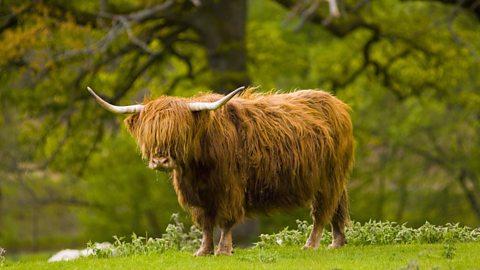Selective breeding
selective breedingAn artificial process in which organisms with desired characteristics are chosen as parents for the next generation. or artificial selection is when humans breed plants and animals for particular genetic characteristics. Humans have bred food crops from wild plants and domesticated animals for thousands of years.
Main steps involved
Selective breeding takes place over many generations. These are the main steps for both plants and animals involve:
- Decide which characteristics are important enough to select.
- Choose parents that show these characteristics from a mixed population. They are bred together.
- Choose the best offspring with the desired characteristics to produce the next generation.
- Repeat the process continuously over many generations, until all offspring show the desired characteristics.

Image caption, Highland cows have been bred for their meat
Image caption, Friesian cows have been bred to produce large volumes of milk
Image caption, Aberdeen Angus cows have also been bred for their meat
1 of 3
Farmers selectively breed different types of cows with highly desirable characteristics in order to produce the best meat and dairy.
Characteristics can be chosen for usefulness or appearance:
Desired characteristics in plants:
- disease resistance in food crops
- wheat plants that produce lots of grain
- large or unusual flowers
Desired characteristics in animals:
- animals that produce lots of milk or meat
- chickens that lay large eggs
- domestic dogs that have a gentle nature
The new varieties may be economically important. For example, they may provide more or better quality food, or allow farmers to feed more people.
Benefits and risks of selective breeding
Because of selective breedingAn artificial process in which organisms with desired characteristics are chosen as parents for the next generation., future generations of selectively bred plants and animals will all share very similar genes which will reduce variation. Genes and their different allelesDifferent forms of the same gene. within a population are known as its gene pool. Inbreeding can lead to a reduced gene pool, making it more difficult to produce new varieties in the future. This also makes organisms prone to certain diseases or inherited defects.
Benefits of selective breeding include:
- new varieties may be economically important, by producing more or better quality food
- animals can be selected that cannot cause harm, for example cattle without horns
Risks of selective breeding include:
- reduced genetic variation can lead to attack by specific insects or disease, which could be extremely destructive
- rare disease genes can be unknowingly selected as part of a positive trait, leading to problems with specific organisms, eg a high percentage of Dalmatian dogs are deaf
- can create physical problems in specific organisms, eg large dogs can have faulty hips due to not being formed correctly